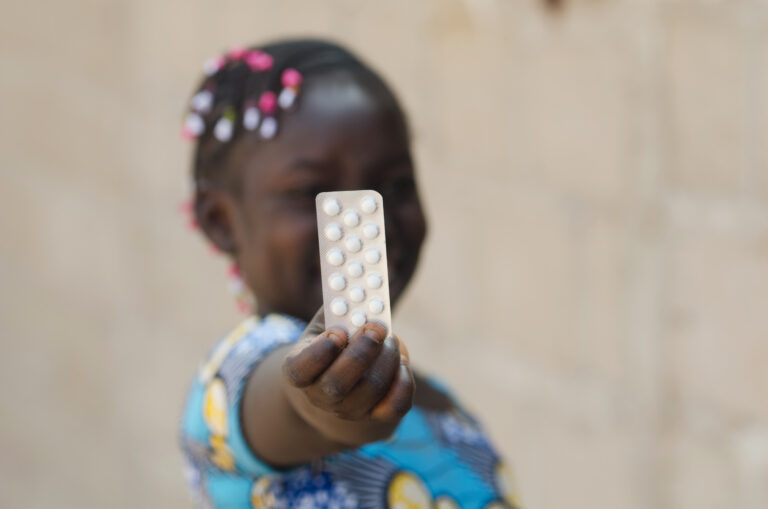What does a dying country like Romania need? More contraceptives and sex ed, according to USAID, which is furiously building up its programs there. Freedom came to Romania with the fall of Ceausescu, but not for the unborn. Decree Number 1 of the new government, passed on the day after Christmas 1989, legalized abortion on demand. It is no coincidence that USAID, which promotes contraception, sterilization, and — more or less openly — abortion, set up shop in Romania at the same time.
USAID Financing
USAID finances reproductive health programs, both directly through its partnership with the Romanian Ministry of Health and indirectly through its labyrinth of non-governmental organizations, notably John Snow International. A number of foreign-funded “Romanian” front organizations have been set up such as Societatea de Educatie Contraceptiva si Sexuala (SECS), Asociatia Romana Anti-SIDA (ARAS) and Population Service International Romania (PSI Romania). SECS, an organization founded in 1992 to represent International Planned Parenthood Federation (IPPF) in Romania, receives 70 percent of its budget from USAID, It runs eight family planning clinics at the national level and has three regional offices, in Constanta, Cluj, and Iasi. PSI Romania runs social marketing programs, which means that it uses various marketing schemes, promotions, giveaways, flyers, posters, radio spots, gimmicks and ad campaigns to promote the wider use of certain contraceptives. Among its USAID-funded campaigns are “I do what I know, but I know what I’m doing,” and “Love Plus,” both of which were designed to push condoms on teenagers.
The head of SECS, Borbala Koo, has been quoted as saying that USAID “has spent more money on reproductive health programs in Romania than the government.” The stated USAID policy in Romania is to “increase access to contraception and improve the quality of life,” obviously because it believes that unrestrained sex is the key to happiness. According to the Mediafax Press Agency, USAID has spent $35 million dollars on reproductive health program since 1990, a huge sum by Romanian standards.
240 Family Planning Offices
Not surprisingly, given all the money and foreign “experts” pouring into Romania, the main aim of the 12th National Health Program of the Ministry of Health is to increase access to family planning services and contraception. “In 2001, there were only[!] 240 family planning offices in Romania. Now, family planning is included in primary health care, and general practitioners offer family planning services,” says SECS Director Koo. The three-year plan, which runs from 2003 to 2006, is designed to turn 6,000 general practitioners into family planning advocates. These doctors are to be paid to urge free contraception on certain targeted groups: rural women, students, the poor and the unemployed. The money for this came from a U.S. $1,805,000 grant explicitly entitled “Coherent law-making and implementing payment mechanisms in reproductive health.”
The Ministry of Health also subsidizes abortions. In state-run clinics an abortion costs only $5. This is a fraction of the cost of an abortion in a private clinic. Moreover, women who receive abortions in state-run clinics are routinely contracepted following the procedure. Because USAID is providing most of the Health Ministry‘s budget for reproductive health programs, it is contributing indirectly, if not directly, to abortion.1
Sex Ed
The “Education for Health” program has brought graphic sex education into our schools, It is funded by all the major population control players: UNAID, UNICEF, UNFPA, UNDP, and the World Bank. In second grade (8–9 years) pupils are taught about differences between men and women. They are supposed to discover body parts through “interactive games.” During the third and fourth grades (9–11 years), students are taught how babies appear and develop in the womb. During the fifth and sixth grades (11–13 years), students are taught about conception, risks of pregnancy and sexual behavior. During the seventh and eighth grades (13–15), they learn about beginning sexual activity and are given “useful addresses” for easy access to contraception and, presumably, abortion. In the final grades, students receive full reproductive health services and are taught “specific aspects of sexual relations.” That is to say, they are given free hormonal contraceptives and condoms.
The teaching material has been criticized by many teachers and organizations for its pornographic pictures and immoral ideas. Pro-life organizations, including Primul Pas (Iasi), Christiana (Cluj), and Pro Filus (Pitesti) have been particularly skeptical of the program because it focuses on contraception and abortion, and does not emphasize morality. Other groups have been critical on the grounds that homosexuality is included in sex education, as well as euthanasia and “scientific eugenics.”
Contraceptive Consequences
Both USAID and the Ministry of Health claim wonderful benefits from promoting sex education and contraceptives — a lower abortion rate, lower maternal mortality, a lower rate of sexually transmitted disease (STDs), etc. Unfortunately, none of these claims are true. Using more contraception actually leads to earlier onset of sexual activity, huge rates of sexually transmitted disease, and a high abortion rate, especially among teenagers.
Statistics show that the increased use of contraceptives has not decreased the number of abortions, but in fact has created more abortions. In 1990, in the turmoil surrounding the collapse of Communism, the number of abortions peaked at 992,880. Since 1993, the number of abortions has been constant, with official statistics tabulating about 250,000 per year. This is not much lower than Great Britain, which has three times the population of Romania.
But even these numbers, high though they are, certainly underestimate the incidence of abortion. A study by Dr. Mihai Horga, a former Ministry of Health official, showed that in 2000 there were 80.000 abortions carried out in private clinics that were not reported to the government.2 Also not counted are “hormonal abortions,” which Professor Virgil Ancar, head of the Obstetrics-Gynecology Clinics of St. Pantelimon Hospital, estimated were 30 percent of the total number of abortions. While so-called emergency contraception (the Morning-After Pill) was not used at all in Romania in 1999, by 2002 a study showed that MAP was used by 8 percent of respondents to a survey.3
But even according to the official statistics, the number of abortions has exceeded the number of live births since 1990. The year 1993 had the worst abortion/live birth ratio when there were 3.4 abortions for each recorded birth. In the first nine months of 2003, there were 8,000 more abortions than births (170,000 abortions versus 162,000 births). There is no law requiring the mother’s informed consent before an abortion.
We believe, with Father Paul Marx and others, that contraception leads to abortion. Contraceptive programs in Romania perpetuate an abortion mentality. Among the consequences of the relentless promotion of contraceptives and the resulting high abortion rate are the highest maternal mortality rate in Europe. In 2000, maternal mortality from all causes was six times higher than in the European Union and three times higher than in other eastern and southern European countries.
STDs Increase
The picture is the same with regard to STDs. Although tens of millions of dollars have been spent on sex education and the promotion of contraception, this has not reduced the incidence of STDs in the least. On the contrary, STDs continue to spread at an alarming rate. In 2002, there were 12,702 cases of syphilis reported to the government, a rate fifty times higher than in other European countries. The number of cases continues to grow each year, with most new infections among young people aged 20 to 29.
Other STDs, such as chlamydia, gonococci. papillomaviruses, etc., are out of control because there are too few laboratories to test for them. In the past four years alone, the number of adults infected with HIV/AIDS has tripled, and Romanian and foreign specialists say the real number may be five to ten times higher than the official figure. In 2003, the World Bank announced the threat of an AIDS epidemic in the Balkans, following case studies in Romania. Bulgaria and Croatia.
What does the Ministry of Health say about this? According to Dr. Alexandru Rafila, director of the ministry’s Department of Maternity, the increase in STDs is due to “sexual intensification.” Many young people turn to sex to “improve their quality of life,” he remarked. Such attitudes surely come in part from sex education. Moreover, despite the tremendous effort devoted to distributing contraceptives, there is no commensurate public health effort devoted to STDs. As Dr. Rafila went on to point out, “There is no network of laboratories at the national level to detect other STDs, gonococci, Chlamydia, and papillomaviruses.”4
New Sexual Ethic
It is clear that, along with the promotion of contraception, a new sexual ethic is being imposed. Since 1990, the age of first sexual activity has slowly dropped. A 2003 Ministry of Health survey showed that 56 percent of teenage girls and 80 percent of teenage boys become sexually active before they turn 19. Prof. Justin Deaconu, from the Prof. Dr. Scarlat Longhin Clinic of Dermato-Venereological Disease in our capital city of Bucharest, says that sexual activity now begins as early as 9 years old, a sad reality that he attributes to “the moral collapse since 1989.” A moral collapse, we might add, that has been aided and abetted by USAID.
As might be expected, USAID categorically denies any link between the increasing use of contraception and the high rate of STDs. Mark Wenig, USAID representative in Romania, claims that in “a 1997 review of 68 studies on the effects of programs such as those financed by USAID on the sexual behavior of young people, the United Nations concluded: ‘little evidence was found to support the notion that sexual and HIV education promote promiscuity’ in any way. The attempt to establish a link between modem contraceptives and STDs is unfounded.”
(Editor’s Note: But Depo-Povera, and presumably other hormonal contraceptives, do increase the risk of contracting STDs by a factor of three. And any parent would take issue with the claim that pornographic, “how-to” sex education does not encourage sexual activity among impressionable teenagers, no matter how many “studies” the population controllers at the UN publish. The point of sex education, from the point of view of the educators, is precisely to affect behavior. They wouldn’t be so keen on it if it didn’t. )
Abortion
This brings us back to the question of abortion, an increasing number of which are being performed on teenagers. Dr. Christa Todea-Gross, coordinator of the “Pro-Vita Project” in Cluj in the Romanian northwest, says. “The statistical data, obtained by counseling, show that in 2002 a larger number of abortions were recorded among students, and that 20 percent of all abortions were ‘abortion on demand.’ Beginning in 200l, 16 and 17-year-olds started requesting abortions. By 2003, girls as young as 16, 15, or even 14 years of age were asking for abortions”
The Romanian Ministry of Health, and the Ministry of Education reject abstinence programs. Encouraged by their foreign backers, they consider them “utopian” or “out-of-date.”5 But the Health Priority Program for 2002 of the Romanian government, in the chapter entitled “National Project to Prevent and Fight STDs,” explicitly says “the key messages in the area of STDs are: (1) Teaching the young responsible sexual behavior; (2) Abstinence or delaying first sexual activity…” It is ignored by USAID.
Larisa Ciochia and Constantin Iftime write from Bucharest, Romania, where they are pro-life, pro-family activists
(Editor’s Note: Romania, in its need and poverty, seems to have become something of a playground for sexual experimentation, even in a personal sense. According to an article in an issue of The American Conservative, high-level embassy and USAID officials in Romania, men of a homosexual bent, have “transformed the U.S. diplomatic addresses into havens of debauchery .… [B]ased on reports and pornographic photos circulated around newspapers… [they] use their privileged positions to corrupt young Romanians, paying them for sexual relations, by both cash and visas to the U.S .…. According to [one] deposition, these acts included multiple sexual encounters with young Romanian men, some of whom may have been minors. The high-ranking USAID official’s taxpayer-provided residence was said to be the site of wild sexually charged parties where participants allegedly used drugs and viewed pornography. He states that this official has made sexually explicit photographs of himself available on the Internet .… ” (W. James Antle III, “The Pink Embassy,” The American Conservative, 24 May 2004.)
If sexual libertines were truly in charge of setting up American-funded aid programs in Romania, what would their policy be? All sex and no babies, of course, which is a pretty good short-hand description of the programs that our correspondents report have been imposed on poor, dying Romania. )
Endnotes
1 The Mexico City Policy bars U.S. funds from going to any organization that promotes, performs or lobbies for legalization of abortion. It does not, however, apply to aid to governments. Even though USAID is complicit in abortion in Romania, because the funding goes directly to the Ministry of Health, rather than to NGO, it is exempt from the Mexico City Policy. The Mexico City Policy needs to be broadened so U.S. taxpayers are not subsidizing abortions in Romania or anyplace else.
2 Dr. Mihai Horga, “Contraception and Abortion in Romania,” background paper for the strategic assessment of policy, programs and research issues related to pregnancy termination in Romania, October 2001.
3 The survey was aimed at “identifying Romanian sexual behavior” and was reported in Adevarul, 6 December 2003.
4 Dr. Alexandru Rafila, Viata Medicala, Number 45, 1–7 November 2003.
5 Cf. Mircea Ifrim, chief of the Health Commission of the Chamber of Deputies.










